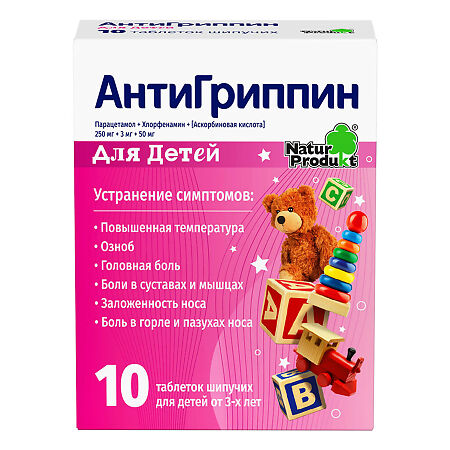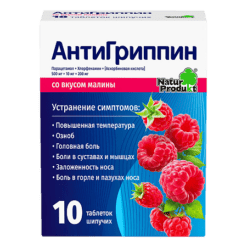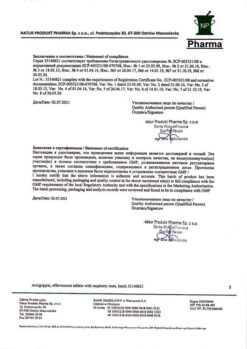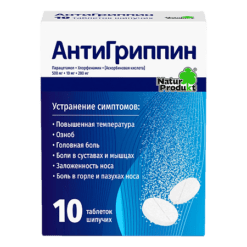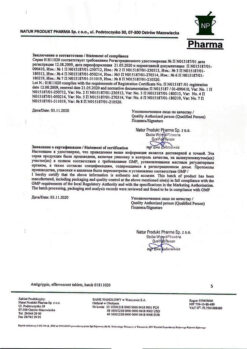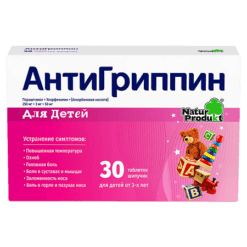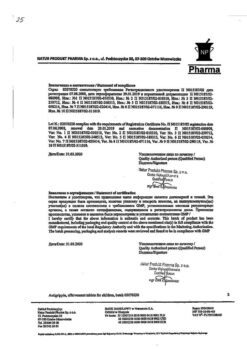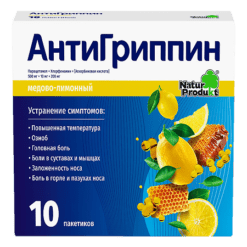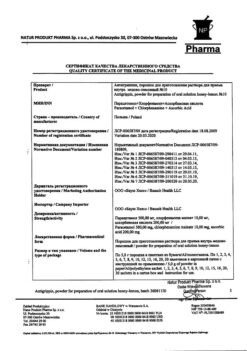No products in the cart.
Antigrippin, for children 250 mg+3 mg+50 mg 10 pcs
€10.85 €9.49
Description
A combined drug.
Paracetamol – has analgesic and antipyretic effect, eliminates headache and other types of pain, reduces fever.
Ascorbic acid (vitamin C) – is involved in the regulation of redox processes and carbohydrate metabolism, increases the body’s resistance.
Chlorphenamine is a blocker of H1-histamine receptors – has anti-allergic effect, facilitates nasal breathing, reduces nasal congestion, sneezing, lacrimation, itching and red eyes.
Indications
Indications
Infectious and inflammatory diseases (ARVI, influenza), accompanied by:
elevated temperature,
pain in joints and muscles,
chills,
headache,
nasal congestion,
pain in the throat and sinuses.
Pharmacological effect
Pharmacological effect
Combined drug.
Paracetamol has an analgesic and antipyretic effect, eliminates headaches and other types of pain, and reduces fever.
Ascorbic acid (vitamin C) – participates in the regulation of redox processes, carbohydrate metabolism, and increases the body’s resistance.
Chlorphenamine – a blocker of H1-histamine receptors – has an antiallergic effect, facilitates breathing through the nose, reduces nasal congestion, sneezing, lacrimation, itching and redness of the eyes.
Special instructions
Special instructions
If you are taking metoclopramide, domperidone or cholestyramine, you should consult your doctor.
With long-term use in doses significantly higher than recommended, the likelihood of liver and kidney dysfunction increases; monitoring of the peripheral blood picture is necessary.
Paracetamol and ascorbic acid can distort laboratory tests (quantitative determination of glucose and uric acid in blood plasma, bilirubin, liver transaminase activity, LDH).
Prescribing ascorbic acid to patients with rapidly proliferating and intensively metastasizing tumors can aggravate the process. In patients with high iron levels in the body, ascorbic acid should be used in minimal doses.
Active ingredient
Active ingredient
Paracetamol, Chlorphenamine, [Ascorbic Acid]
Active components
Active components
ascorbic acid (ascorbic acid) Rec.INN registered by WHO paracetamol (paracetamol) Rec.INN registered by WHO
chlorphenamine Rec.INN registered WHO
Composition
Composition
1 effervescent tablet contains:
Active substances:
paracetamol – 250 mg,
ascorbic acid – 50 mg,
chlorphenamine maleate – 3 mg.
Excipients:
sodium bicarbonate;
citric acid;
sorbitol;
povidone;
sodium saccharinate;
sodium carbonate;
macrogol;
silicon dioxide;
fruit flavoring (aromatic fruit additive “Red Fruits”)
Pregnancy
Pregnancy
not provided
Contraindications
Contraindications
Hypersensitivity to paracetamol, ascorbic acid, chlorphenamine or any other component of the drug.
Erosive and ulcerative lesions of the gastrointestinal tract (in the acute phase).
Severe renal and/or liver failure.
Angle-closure glaucoma.
For powder for the preparation of a honey-lemon or chamomile solution for oral administration, effervescent tablets with raspberry or grapefruit flavor, effervescent tablets (optional): alcoholism; phenylketonuria; prostatic hyperplasia; children under 15 years of age; pregnancy; lactation period.
For effervescent tablets for children (optional) – children under 3 years of age.
With caution:
renal and/or liver failure; deficiency of glucose-6-phosphate dehydrogenase; congenital hyperbilirubinemia (Gilbert, Dubin-Johnson and Rotor syndromes); viral hepatitis.
Side Effects
Side Effects
The drug is well tolerated in recommended doses.
From the nervous system: in isolated cases – headache, feeling of fatigue.
From the digestive system: in isolated cases – nausea, pain in the epigastric region.
From the endocrine system: in isolated cases – hypoglycemia (up to the development of coma).
From the hematopoietic system: in isolated cases – anemia, hemolytic anemia (especially for patients with glucose-6-phosphate dehydrogenase deficiency); extremely rarely – thrombocytopenia.
Allergic reactions: in isolated cases – skin rash, itching, urticaria, Quincke’s edema.
Other: hypervitaminosis, metabolic disorders, feeling of heat, dry mouth, accommodation paresis, urinary retention, drowsiness.
The patient should report all side effects to the doctor.
Interaction
Interaction
Ethanol enhances the sedative effect of antihistamines.
Antidepressants, antiparkinsonian drugs, antipsychotic drugs (phenothiazine derivatives): increase the risk of side effects (urinary retention, dry mouth, constipation).
GCS: increase the risk of developing glaucoma.
With simultaneous use, the positive chronotropic effect of isoprenaline decreases.
Reduces the therapeutic effect of antipsychotic drugs (neuroleptics) – phenothiazine derivatives, tubular reabsorption of amphetamine and tricyclic antidepressants.
Inducers of microsomal oxidation in the liver (phenytoin, ethanol, barbiturates, rifampicin, phenylbutazone, tricyclic antidepressants): increase the production of hydroxylated active metabolites, which makes it possible to develop severe intoxications with small overdoses. Ethanol contributes to the development of acute pancreatitis.
Inhibitors of microsomal oxidation (including cimetidine): reduce the risk of hepatotoxicity.
Simultaneous use of the drug Antigrippin and diflunisal: the concentration in the blood plasma of paracetamol increases by 50%, resulting in increased hepatotoxicity.
Simultaneous use of barbiturates reduces the effectiveness of paracetamol and increases the excretion of ascorbic acid in the urine.
Paracetamol: reduces the effectiveness of uricosuric drugs.
Overdose
Overdose
Symptoms: caused by the substances included in the composition. The clinical picture of an acute overdose of paracetamol develops within 6–14 hours after its administration.
Symptoms of chronic overdose: appear 2–4 days after increasing the dose of the drug.
Symptoms of acute paracetamol overdose: diarrhea, loss of appetite, nausea and vomiting, abdominal discomfort and/or abdominal pain, increased sweating.
Symptoms of an overdose of chlorphenamine: dizziness, agitation, sleep disturbance, depression, convulsions.
Treatment: symptomatic.
Short product description
Short product description
Complex drug for symptomatic treatment of ARVI.
AntiGrippin – triple strength against 8 symptoms of ARVI and colds.
For children from 3 years old.
1) 3 active components act on 8 symptoms of ARVI and colds
2) AntiGrippin for children does not contain sugar
Storage conditions
Storage conditions
The drug should be stored out of the reach of children at a temperature not exceeding 25°C.
Shelf life
Shelf life
Shelf life – 3 years. Do not use after expiration date.
Manufacturer
Manufacturer
Natur Product Pharma Sp. z o.o., Poland
Additional information
| Shelf life | 3 years |
|---|---|
| Conditions of storage | At 10-30 °C |
| Manufacturer | Natur Produkt Pharma, Poland |
| Medication form | effervescent tablets |
| Brand | Natur Produkt Pharma |
Other forms…
Related products
Buy Antigrippin, for children 250 mg+3 mg+50 mg 10 pcs with delivery to USA, UK, Europe and over 120 other countries.

